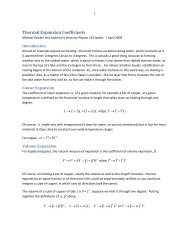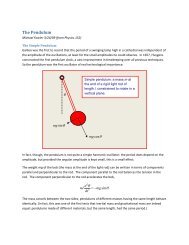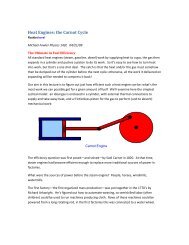Vectors - Galileo and Einstein
Vectors - Galileo and Einstein
Vectors - Galileo and Einstein
You also want an ePaper? Increase the reach of your titles
YUMPU automatically turns print PDFs into web optimized ePapers that Google loves.
Describing Motion in Two <strong>and</strong> Three Dimensions: <strong>Vectors</strong>Michael Fowler, Physics 142E Lec 4. 20 Jan 2009DisplacementsWe’ve analyzed motion of an object (like a small ball) in one dimension fairly thoroughly, using theconcepts of displacement (meaning position, or x-coordinate), velocity (rate of change of x-coordinate)<strong>and</strong> acceleration (rate of change of velocity). Let’s now generalize these ideas to a ball being movedaround—displaced—in a plane. For one dimension, displacement had a magnitude <strong>and</strong> a sign (forwardsof backwards from the origin?).In two dimensions displacement has a magnitude <strong>and</strong> a direction. A displacement of one meter fromthe origin could l<strong>and</strong> you anywhere on a circle. The st<strong>and</strong>ard way of representing a displacement in aplane is with a vector, an arrow whose length indicates distance, with some agreed scale, such as 1 cmrepresenting 1 m, <strong>and</strong> whose direction represents the direction of the displacement.An equivalent representation is to give the displacement from the origin as a sum of displacements inthe x-direction <strong>and</strong> the y-direction; these are called the components of the displacement.C5 meters3 metersA4 metersBIf the ball rolls from A to C along the red line, its displacement from A canbe represented by the red arrow.The identical displacement can be achieved by first moving the ball to B,then up to C: the two black vectors add to the red vector.
2In fact, this gives us the clue for adding vectors: it’s just the way we add displacements, if I walk 5 stepsin one direction, <strong>and</strong> represent that by a vector, then walk 2 steps in a different direction, anothervector, evidently my total displacement from my starting position is given by adding the twodisplacements, putting the vectors “head to tail”B A + =B =C <strong>Vectors</strong> always add by the “head to tail” ruleC A This addition is like making a map of the path taken—paths add up this way, so vector displacements dotoo. And, it doesn’t matter which move you make first: A B B Afor vectorsThe magnitude (or length) of the vector A is sometimes called the modulus, <strong>and</strong> can be denoted by |A|or sometimes just A.It’s evident that if A is a vector, A + A is a vector twice as long in the same direction—<strong>and</strong> we definethe product of a vector A <strong>and</strong> a positive number b, b A , to be a vector in the same direction as A , oflength bA. If b is a negative number, the vector b A points in the opposite direction, so, for example, A A . 0 It’s also clear from the above how to subtract vectors: since AB C, we have C A B. Fromthe first diagram above, we can see from this that the way to find the difference of two vectors, in this
3 case CA , is to put their tails together <strong>and</strong> draw a vector B from the head of A to the head of C :this vector is the difference vector (check by adding it to A to get C !)Vector Components <strong>and</strong> Unit <strong>Vectors</strong>As mentioned at the beginning of this section, any displacement from the origin can be written as a sumof displacements in the x-direction <strong>and</strong> the y-direction; these being called the components of thedisplacement.More generally, it’s clear that any two-dimensional vector is a sum of a vector in the x-direction <strong>and</strong> onein the y-direction, <strong>and</strong> in fact any three-dimensional vector has an additional contribution in the z-direction.This decomposition is best represented by introducing three unit vectors ( length 1) denotedthe directions of the three axes, <strong>and</strong> writing a vector A as:ˆ ˆ ˆA A i A j A k.x y zˆ ˆ ˆi , j,k , inIn fact, the vector is often written simply:A A , A , A .x y zThe numbers Ax , Ay , Azare called the components of the vector.yĵi ˆA A yxA xVector, unit vectors <strong>and</strong> vector components in two dimensions
4Note that from Pythagoras’ theorem the length of the vector is related to the length of the components:A A A , <strong>and</strong> in three dimensions this becomes A A A A2 2 2x y2 2 2 2 xyz.It’s also worth noting that if the angle between A <strong>and</strong> the x-axis is θ, then A Acos , A Asin .The component representation is a h<strong>and</strong>y alternative to the graphical approach: two vectors addtogether simply by adding their components, etc., for example: A2B A 2 B , A 2 B , A 2 B .x x y y z zAll problems about vectors can be h<strong>and</strong>led using components, but the graphical approach will often givemore insight into what’s going on.Vector Kinematics: Velocity <strong>and</strong> Acceleration <strong>Vectors</strong>Recall that in lecture 2 we defined velocity along a line at a given time by vtlimt2t10t t t1 2 2 1 x t2 x t1dxt t dtxyThe obvious generalization to three dimensions is:where r is the position vector.vt limt2t10t t t1 2 r t2r t1drt t dtSuppose now a particle is moving along a curved path in a plane. Then the direction of the velocity vector at some time is the direction of the vector r2r1, where these are two points very close togetheron the curve—if you draw the curve, you’ll see this direction is just the tangent to the curve. Of course,as the particle moves along the curve, at any instant its velocity is in the direction of the curve.2 1The direction of acceleration for motion is a plane is a lot less obvious. Generalizing the formulas forone dimension in lecture 2, average acceleration over a time perioda t v tt v t 2 1t2 1,<strong>and</strong> acceleration at a given time tat 2 1lim .t2t10tt t t 2t1dt1 2 v t v t dv
5Formally, this is just like one dimension, but there’s a new wrinkle—the velocity can change without thespeed changing. The simplest example is a car going round a bend at constant speed: the velocitychanges direction, so there’s a nonzero change in velocity:vt 1 vt 2 v t v t 2 1Acceleration is perpendicular to velocity for motion round a curve at constant speedWhen we get to Newton’s laws, we’ll find that this not-so-obvious kind of acceleration is just asimportant as old fashioned step-on-the-gas acceleration—both are the response of an object to anexternal force.Relative Velocities: a Child Running in a TrainConsider a child running at 3 meters per second (about 6 mph) in a train. The child is running parallel tothe length of the train, towards the front, <strong>and</strong> the train is moving down the track at 30 meters persecond. What is the child’s velocity relative to the ground? It is 33 meters per second in the directionthe train is moving along the track (notice we always specify direction for a velocity). To really nail thisdown, you should think through just how far the child moves relative to the ground in one second—three meters closer to the front of the train, <strong>and</strong> the train has covered 30 meters of ground.A trickier point arises if the child is running across the train, from one side to the other. (This run willonly last about one second!) Again, the way to find the child’s velocity relative to the ground is tovisualize how much ground the child covers in one second—three meters in the direction across thetrack, from one side to the other, plus thirty meters in the direction along the track.














